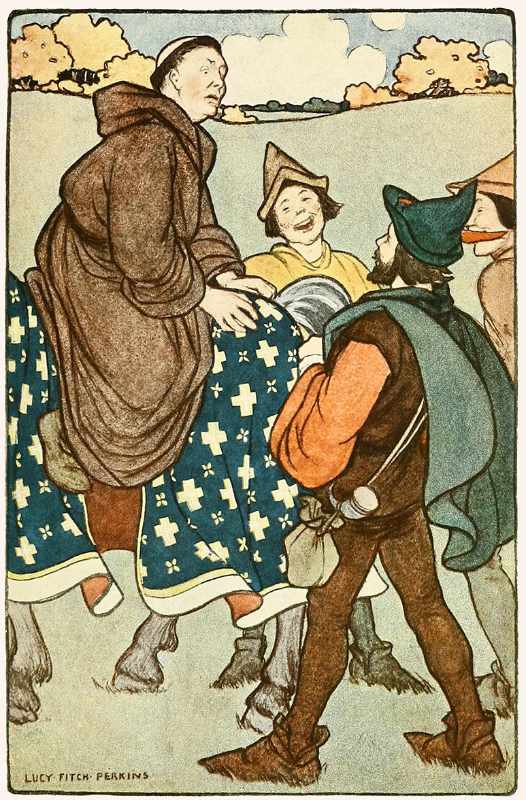The Bishop of Hereford is a character in the Robin Hood legend. He is typically portrayed as a wealthy and greedy clergyman who is robbed by Robin and his Merry Men. The character first appears by this name in the ballad “Robin Hood and the Bishop of Hereford”. The earliest surviving text dates to the 1670s. Relying on later printed versions, Francis James Child collected the work as Child Ballad 144. In the song, Robin Hood and some of his men, disguised as shepherds, poach a deer in an area where they know the Bishop of Hereford will pass through. Finding them, the Bishop threatens to bring them before King Richard, and refuses to grant them pardon. Robin summons his Merry Men, who capture the Bishop and force him to “pay for” a feast with the outlaws and to sing a mass for them. Child Ballad 143, “Robin Hood and the Bishop”, features an unidentified bishop and ends in a nearly identical way. Both are variants of the episode in the much older “A Gest of Robyn Hode” in which Robin robs a monk. The Bishop of Hereford appears in the subsequent Child Ballad, “Robin Hood and Queen Katherine”, in which he refers to the action in the previous work and refuses to bet on Robin in an archery contest. Scholar Stephen Knight notes that there are multiple historical Bishops of Hereford who have been suggested as a model for the character in the ballads. He may have been based on Adam Orleton, Bishop from 1317 to 1327, an antagonist of Edward II of England who became very unpopular during the reign of Edward III. He was a well-known figure at the time the earliest Robin Hood ballads likely developed in the 14th century. The Bishop of Hereford appears in Howard Pyle’s influential children’s book The Merry Adventures of Robin Hood (1883), based on the medieval ballads. The Merry Men rob him to pay Sir Richard at the Lee’s debt. Later, he is scheduled to perform the marriage of Alan-a-Dale’s sweetheart to her unwanted wooer, until Robin intervenes. He also appears in the archery contest scene, where the Queen (here Eleanor of Aquitaine) attributes his refusal to bet on Robin more to greed than to the impropriety of his betting.
| Alias The Bishop of Hereford |
| Real Names/Alt Names Unknown (possibly Adam Orleton, Peter of Aigueblanche, or William de Vere) |
| Characteristics Archer, Robin Hood Universe, Medieval Age, British |
| Creators/Key Contributors Unknown |
| First Appearance English folklore |
| First Publisher ○ |
| Appearance List Ballads: A Gest of Robyn Hode, Robin Hood and the Monk, Robin Hood and the Curtal Friar, Robin Hood and Allin a Dalem, Robin Hood and Queen Catherin, Robin Hood and the Golden Arrow, Robin Hood and the Tanner of Blyth. Literature: The Merry Adventures of Robin Hood by Howard Pyle (1883, PG), Robin Hood by Paul Creswick (PG), Robin Hood by Anonymous (PG), Bold Robin Hood-And His Outlaw Band by Louis Rhead (1912, Internet Archive), Robin Hood and the Men of the Greenwood (1920) [Internet Archive], Robin Hood: His Deeds and Adventures as Recounted in the Old English Ballads (1923) [Internet Archive]. |
| Sample Read The Merry Adventures of Robin Hood [PG] |
| Description The Bishop of Hereford is a character in the Robin Hood legend. He is typically portrayed as a wealthy and greedy clergyman who is robbed by Robin and his Merry Men. The character first appears by this name in the ballad “Robin Hood and the Bishop of Hereford”. The earliest surviving text dates to the 1670s. Relying on later printed versions, Francis James Child collected the work as Child Ballad 144. In the song, Robin Hood and some of his men, disguised as shepherds, poach a deer in an area where they know the Bishop of Hereford will pass through. Finding them, the Bishop threatens to bring them before King Richard, and refuses to grant them pardon. Robin summons his Merry Men, who capture the Bishop and force him to “pay for” a feast with the outlaws and to sing a mass for them. Child Ballad 143, “Robin Hood and the Bishop”, features an unidentified bishop and ends in a nearly identical way. Both are variants of the episode in the much older “A Gest of Robyn Hode” in which Robin robs a monk. The Bishop of Hereford appears in the subsequent Child Ballad, “Robin Hood and Queen Katherine”, in which he refers to the action in the previous work and refuses to bet on Robin in an archery contest. Scholar Stephen Knight notes that there are multiple historical Bishops of Hereford who have been suggested as a model for the character in the ballads. He may have been based on Adam Orleton, Bishop from 1317 to 1327, an antagonist of Edward II of England who became very unpopular during the reign of Edward III. He was a well-known figure at the time the earliest Robin Hood ballads likely developed in the 14th century. The Bishop of Hereford appears in Howard Pyle’s influential children’s book The Merry Adventures of Robin Hood (1883), based on the medieval ballads. The Merry Men rob him to pay Sir Richard at the Lee’s debt. Later, he is scheduled to perform the marriage of Alan-a-Dale’s sweetheart to her unwanted wooer, until Robin intervenes. He also appears in the archery contest scene, where the Queen (here Eleanor of Aquitaine) attributes his refusal to bet on Robin more to greed than to the impropriety of his betting. |
| Source Bishop of Hereford (Robin Hood) – Wikipedia |

